- Joined
- Feb 2, 2011
- Messages
- 2,379
THE ANCIENTS
ARMIES AND ENEMIES OF THE NEW KINGDOM EGYPTIANS
THE HITTITES
Between the 15th and 13th centuries BC, the Hittites were one of the dominant powers of the near east, and clashed with the other main three powers, Egypt, the middle Assyrians and the empire of Mitanni.
The Hittite prosperity was mostly dependent on control of the trade routes and natural metal resources.
Because of the importance of northern Syria to the vital routes linking the Cilician gates with Mesopotamia, defence of this area was crucial, and was challenged by the Egyptian expansion under Pharaoh Ramesses II.
The Battle of Kadesh took place in the 13th century BC between the Egyptian Empire led by pharaoh Ramesses II and the Hittite Empire led by king Muwatalli II.
Their armies engaged each other at the Orontes river, just upstream of lake Homs and near the archaeological site of the fortified city of Kadesh.
It is generally dated to May 1274 BC, as accounted by Egyptian chronology, and is the earliest pitched battle in recorded history for which details of tactics and formations are known.
It is believed to be the largest battle ever fought involving chariots, numbering a total of around 6,000.
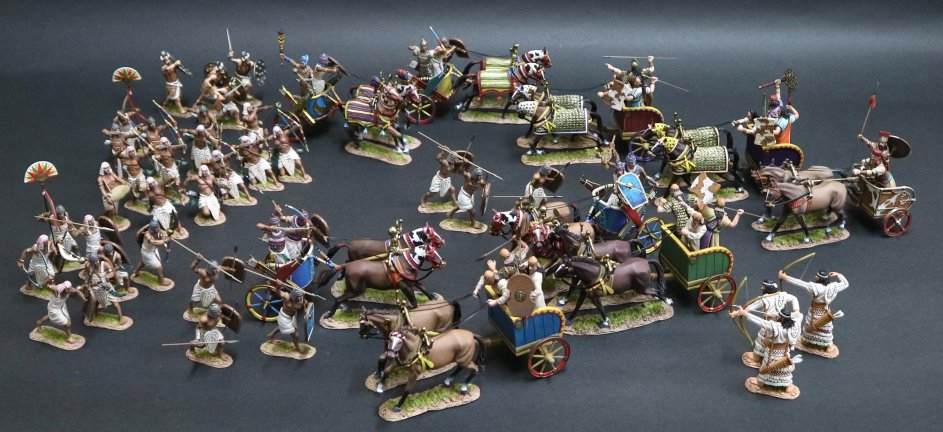
Kadesh remains a popular battle with historians because of the detailed pictorial representations left by Rameses II on the walls of temples at Thebes, Karnak, Luxor, Agydos and Abu Simbel.
As Rameses army marched up from the south, the Hittite king Muwatallis II, launched his attack by despatching 2,500 chariots in four bodies across the Orontes via a ford just below the fortified city of Kadesh.
The Egyptian records describe how these chariots cut through the army of Ra in its middle, while they were marching without knowing and without being drawn up for battle, which broke the army and caused panic. The fleeing army fell into confusion against the army of Amun the second Egyptian army to the north, which also fell into confusion and flight.
The Hittites followed up this initial attack and finally encircled the Egyptian camp. Rameses’ personal leadership and tactical dexterity in the swirling chariot battle saved him at the decisive moment, and he was able to snatch victory from the jaws of defeat.
The outcome of the Battle of Kadesh is uncertain, although the timely arrival of Egyptian reinforcements prevented a total Hittite victory, the Egyptians did force the Hittites to take refuge in the fortress city of Kadesh, but their own losses prevented them from sustaining a siege.
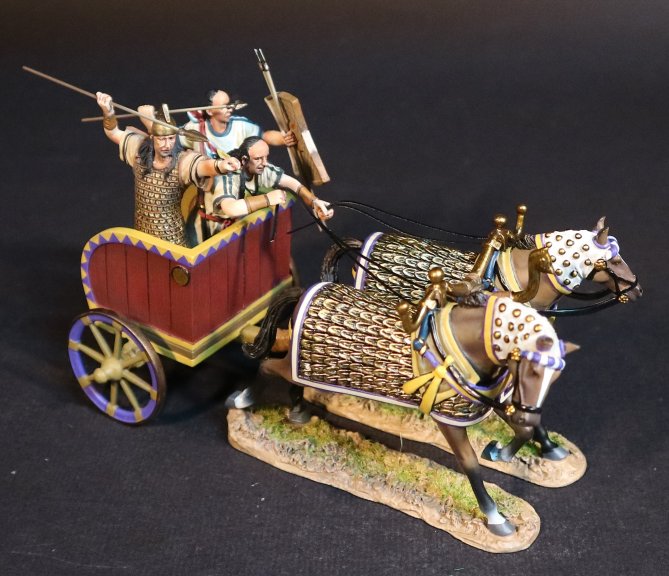
HITT-02
THE ANCIENTS,
NEW KINGDOM EGYPTIANS,
THE BATTLE OF KADESH 1274BC,
HITTITE WAR CHARIOT
ARMIES AND ENEMIES OF ANCIENT ROME
THE SAMNITES
The Samnites and their relatives in central and south Italy are known as Oscans, from the name of their language.
The Samnites were the largest and most important Oscan nation, and was made up of a league of four tribes, the Pentri, Caudidi, Hirpini and Caraceni.

The Samnites fought a series of wars with Rome from 343 to 272, and were by far Rome’s most formidable Italian foe. Many Samnites were later to join Hannibal.
Livy the early Roman historian states that the Samnites fought in a loose phalanx formation in the form of a square, which was tactically flexible and more suited to their hilly terrain.
The Greek style phalanx was a formidable weapon especially from the front. But it was not flexible and once in contact with the enemy was vulnerable on its unprotected flanks and rear. It also need level, open terrain for its cohesion. The Romans had used the Phalanx to great effect along the coastal plains, but war in the constricted terrain of the mountainous spine of central Italy meant the Roman phalanx was a failiure. The Samnites did well in mobile warfare and were well used to mountain ambushes.
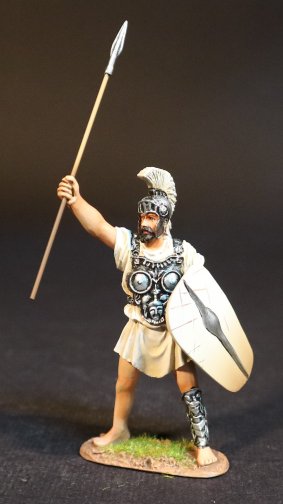
CTSM-01
ARMIES AND ENEMIES OF ANCIENT ROME,
THE SAMNITES,
SAMNITE WARRIOR
The Roman phalanx with its advantage of brute strength would probably defeat the Samnites on the level plain, but the Romans had to learn different tactics when confronted by the Samnites.
The large legion was therefore developed into three lines, with each line in turn broken up into small blocks capable of independent manoeuvre.
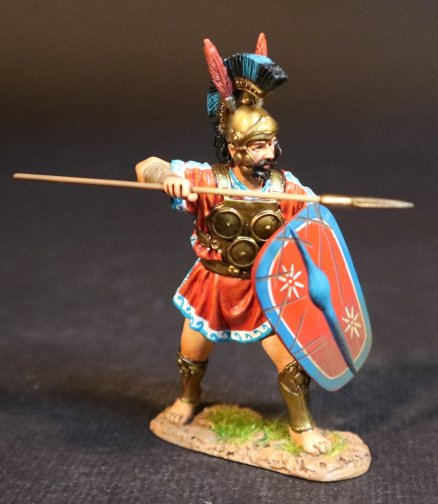
CTSM-02A
ARMIES AND ENEMIES OF ANCIENT ROME,
THE SAMNITES,
SAMNITE WARRIOR
Samnite tunics were brightly coloured and decorated, and there is little evidence of uniformity.
Their weapons included the javelin and short spear. There was a mixture of oval and round shields, and many infantry wore a distinctive cuirasse of Italian design. Small breast and backplates of leather backed bronze linked by hinged straps of similar construction passing over the shoulders and under the arms. The commonest type was the triple disc style.
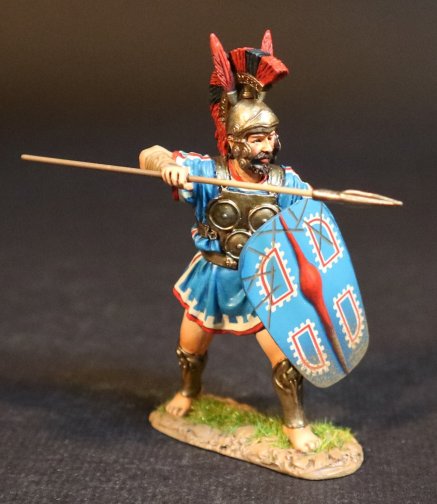
CTSM-02B
ARMIES AND ENEMIES OF ANCIENT ROME,
THE SAMNITES,
SAMNITE WARRIOR
The proportion of cavalry fielded is never mentioned in historical references, but it is assumed it was low, as the wooded mountains would not have been good cavalry country. Like the Romans the Samnite cavalry were organized into Turmae.
Many paintings show warriors carrying spears over their shoulders with bright cloths hanging from them. These are often interpreted as flags, but it is believed that they were tunics and belts. These represent trophies taken from the dead or captured enemy who had been stripped, which was a common practice in both Italy and Greece.
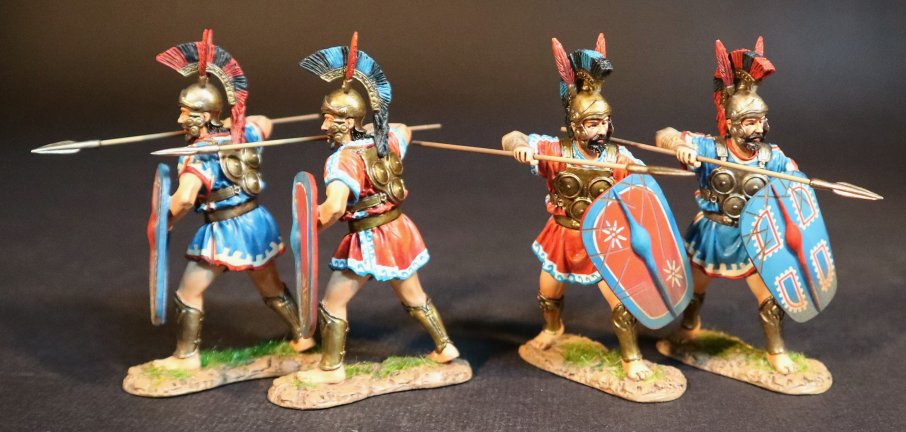
CTSM-02N
ARMIES AND ENEMIES OF ANCIENT ROME,
THE SAMNITES,
SAMNITE WARRIORS
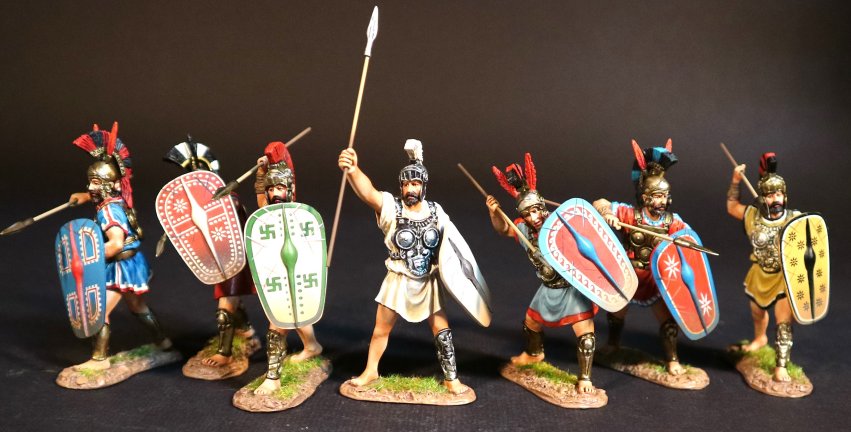
ARMIES AND ENEMIES OF GREECE AND MACEDONIA
THE MACEDONIAN ARMY
THE ARGYRASPIDES (SILVER SHIELD)
The Argyraspides were elite Macedonian soldiers who carried silver plated shields. The original unit were Hypaspists serving in the army of Alexander the Great.
They were a division of the Macedonian army, and were picked men commanded by Nicanort, the son of Parmenio, as well as Seleucus, and were held in high honour by Alexander.
They were hypaspists, having changed their name to the Argyraspides whilst in India under Alexander.
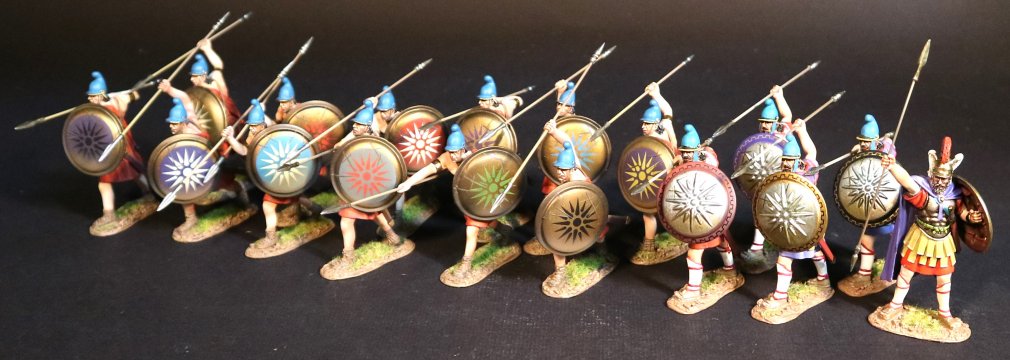
NICANOR, SON OF PARMENIO,
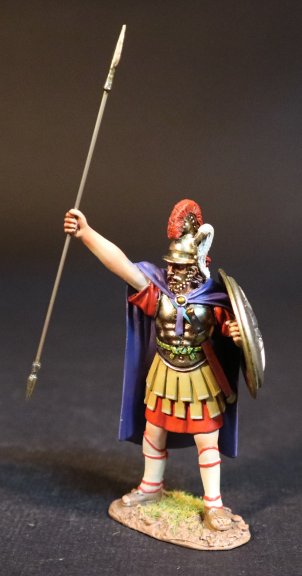
MACSS-01
ARMIES AND ENEMIES OF ANCIENT GREECE AND MACEDONIA,
THE MACEDONIANS,
MACEDONIAN ARGYRASPIDES (SILVER SHIELD),
NICANOR, SON OF PARMENIO
Nicanor, was a distinguished officer in the service of Alexander the Great.
He is first mentioned at the passage of the Danube river, in the expedition of Alexander against the Getae, 335, when he led the phalanx.
During the expedition into Asia he appears to have held the chief command of the Hypaspists.
It is mentioned of him holding this post in the three great battles of the Granicus, Issus and of Gaugamela.
He was to accompany Alexander during the rapid march in pursuit of the king Darius III Codmannus in 330. This was probably his last service, as he was to die of disease shortly afterwards, during the advance into Bactria.
His death at this time was considered a fortunate event, as it prevented him from participating either in the designs or the fate of his brother Philotas.
Contact your Dealer to pre-order today!
ARMIES AND ENEMIES OF THE NEW KINGDOM EGYPTIANS
THE HITTITES
Between the 15th and 13th centuries BC, the Hittites were one of the dominant powers of the near east, and clashed with the other main three powers, Egypt, the middle Assyrians and the empire of Mitanni.
The Hittite prosperity was mostly dependent on control of the trade routes and natural metal resources.
Because of the importance of northern Syria to the vital routes linking the Cilician gates with Mesopotamia, defence of this area was crucial, and was challenged by the Egyptian expansion under Pharaoh Ramesses II.
The Battle of Kadesh took place in the 13th century BC between the Egyptian Empire led by pharaoh Ramesses II and the Hittite Empire led by king Muwatalli II.
Their armies engaged each other at the Orontes river, just upstream of lake Homs and near the archaeological site of the fortified city of Kadesh.
It is generally dated to May 1274 BC, as accounted by Egyptian chronology, and is the earliest pitched battle in recorded history for which details of tactics and formations are known.
It is believed to be the largest battle ever fought involving chariots, numbering a total of around 6,000.

Kadesh remains a popular battle with historians because of the detailed pictorial representations left by Rameses II on the walls of temples at Thebes, Karnak, Luxor, Agydos and Abu Simbel.
As Rameses army marched up from the south, the Hittite king Muwatallis II, launched his attack by despatching 2,500 chariots in four bodies across the Orontes via a ford just below the fortified city of Kadesh.
The Egyptian records describe how these chariots cut through the army of Ra in its middle, while they were marching without knowing and without being drawn up for battle, which broke the army and caused panic. The fleeing army fell into confusion against the army of Amun the second Egyptian army to the north, which also fell into confusion and flight.
The Hittites followed up this initial attack and finally encircled the Egyptian camp. Rameses’ personal leadership and tactical dexterity in the swirling chariot battle saved him at the decisive moment, and he was able to snatch victory from the jaws of defeat.
The outcome of the Battle of Kadesh is uncertain, although the timely arrival of Egyptian reinforcements prevented a total Hittite victory, the Egyptians did force the Hittites to take refuge in the fortress city of Kadesh, but their own losses prevented them from sustaining a siege.

HITT-02
THE ANCIENTS,
NEW KINGDOM EGYPTIANS,
THE BATTLE OF KADESH 1274BC,
HITTITE WAR CHARIOT
ARMIES AND ENEMIES OF ANCIENT ROME
THE SAMNITES
The Samnites and their relatives in central and south Italy are known as Oscans, from the name of their language.
The Samnites were the largest and most important Oscan nation, and was made up of a league of four tribes, the Pentri, Caudidi, Hirpini and Caraceni.

The Samnites fought a series of wars with Rome from 343 to 272, and were by far Rome’s most formidable Italian foe. Many Samnites were later to join Hannibal.
Livy the early Roman historian states that the Samnites fought in a loose phalanx formation in the form of a square, which was tactically flexible and more suited to their hilly terrain.
The Greek style phalanx was a formidable weapon especially from the front. But it was not flexible and once in contact with the enemy was vulnerable on its unprotected flanks and rear. It also need level, open terrain for its cohesion. The Romans had used the Phalanx to great effect along the coastal plains, but war in the constricted terrain of the mountainous spine of central Italy meant the Roman phalanx was a failiure. The Samnites did well in mobile warfare and were well used to mountain ambushes.

CTSM-01
ARMIES AND ENEMIES OF ANCIENT ROME,
THE SAMNITES,
SAMNITE WARRIOR
The Roman phalanx with its advantage of brute strength would probably defeat the Samnites on the level plain, but the Romans had to learn different tactics when confronted by the Samnites.
The large legion was therefore developed into three lines, with each line in turn broken up into small blocks capable of independent manoeuvre.

CTSM-02A
ARMIES AND ENEMIES OF ANCIENT ROME,
THE SAMNITES,
SAMNITE WARRIOR
Samnite tunics were brightly coloured and decorated, and there is little evidence of uniformity.
Their weapons included the javelin and short spear. There was a mixture of oval and round shields, and many infantry wore a distinctive cuirasse of Italian design. Small breast and backplates of leather backed bronze linked by hinged straps of similar construction passing over the shoulders and under the arms. The commonest type was the triple disc style.

CTSM-02B
ARMIES AND ENEMIES OF ANCIENT ROME,
THE SAMNITES,
SAMNITE WARRIOR
The proportion of cavalry fielded is never mentioned in historical references, but it is assumed it was low, as the wooded mountains would not have been good cavalry country. Like the Romans the Samnite cavalry were organized into Turmae.
Many paintings show warriors carrying spears over their shoulders with bright cloths hanging from them. These are often interpreted as flags, but it is believed that they were tunics and belts. These represent trophies taken from the dead or captured enemy who had been stripped, which was a common practice in both Italy and Greece.

CTSM-02N
ARMIES AND ENEMIES OF ANCIENT ROME,
THE SAMNITES,
SAMNITE WARRIORS

ARMIES AND ENEMIES OF GREECE AND MACEDONIA
THE MACEDONIAN ARMY
THE ARGYRASPIDES (SILVER SHIELD)
The Argyraspides were elite Macedonian soldiers who carried silver plated shields. The original unit were Hypaspists serving in the army of Alexander the Great.
They were a division of the Macedonian army, and were picked men commanded by Nicanort, the son of Parmenio, as well as Seleucus, and were held in high honour by Alexander.
They were hypaspists, having changed their name to the Argyraspides whilst in India under Alexander.

NICANOR, SON OF PARMENIO,

MACSS-01
ARMIES AND ENEMIES OF ANCIENT GREECE AND MACEDONIA,
THE MACEDONIANS,
MACEDONIAN ARGYRASPIDES (SILVER SHIELD),
NICANOR, SON OF PARMENIO
Nicanor, was a distinguished officer in the service of Alexander the Great.
He is first mentioned at the passage of the Danube river, in the expedition of Alexander against the Getae, 335, when he led the phalanx.
During the expedition into Asia he appears to have held the chief command of the Hypaspists.
It is mentioned of him holding this post in the three great battles of the Granicus, Issus and of Gaugamela.
He was to accompany Alexander during the rapid march in pursuit of the king Darius III Codmannus in 330. This was probably his last service, as he was to die of disease shortly afterwards, during the advance into Bactria.
His death at this time was considered a fortunate event, as it prevented him from participating either in the designs or the fate of his brother Philotas.
Contact your Dealer to pre-order today!

